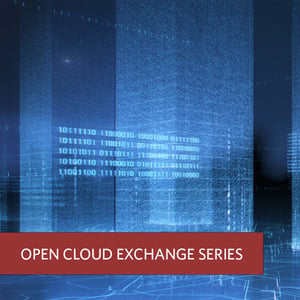
The Open Cloud Exchange: Frequently Asked Questions About Interconnection
Previous blogs about the Open Cloud Exchange® (OCX) explain what it is and why to use it, along with deployment scenarios and tips. This blog provides answers to frequently asked questions about interconnection and how it supports digital transformation (DX). If your DX team is evaluating hybrid cloud, multicloud and networking solutions, read on to learn how the OCX can speed your modernization journey, improve business agility and reduce total cost of ownership.
What are the top reasons enterprises join the Open Cloud Exchange?
Enterprises join the OCX ecosystem to:
- Simplify hybrid cloud and multicloud network architectures. Enterprises can use the OCX to access the major cloud service providers (CSPs) via a single port and single platform, making cloud easy to consume.
- Enhance efficiency and security by consuming CSP services through direct, automated and private connections.
- Enable fast, secure data exchange among OCX members.
- Use intermarket connectivity to deploy new applications and expand the business into other areas of the U.S.
Why is direct connection to a CSP important?
Direct connections offer private network isolation. They’re enabled by “native onramps” that move your data from your colocation space to a CSP without exposing the data to the internet. This approach reduces cost, lowers security risks and reduces latency compared to internet connections.
What cost savings do Open Cloud Exchange members capture?
By utilizing already-built private networking solutions, you can avoid the costs associated with building an on-premises data center. Also, private, direct connectivity saves up to 70% of data egress fees charged by the CSPs when you move data out of the cloud.* If you contract directly with traditional carriers, you can lower costs associated with managing multiple carriers and contracts. Additionally, OCX’s flexible month-to-month service fees eliminate long-term financial commitments, and consolidated billing from CoreSite reduces accounting time and expense.
What are the expected operational benefits?
As members of the OCX, your enterprise and the CSPs are side by side in the same data center. Proximity helps ensure optimal performance. The OCX also simplifies operations, providing network redundancy with guaranteed throughput, so you won’t experience an interruption in service or performance degradation. OCX’s self-service portal provides single-pane-of-glass management and on-demand provisioning. And, you can connect rapidly and easily with other businesses in the OCX community: CSPs, managed service providers, content delivery networks (CDNs), network service providers, service integrators and other enterprises.
How does the OCX help support security/compliance requirements?
The OCX operates inside data centers that hold HIPAA, PCI DSS, ISO 27001, NIST 800-53, SOC 1/Type 2 and SOC 2/Type 2 certifications. Additionally, the facilities’ physical security includes guards, biometrics, cameras and other controls.
What are cloud regions and CoreSite markets, and why are they relevant to DX strategies?
Each of the four major CSPs – Google Cloud, Microsoft Azure, Oracle Cloud and AWS – set up geographic regions in the U.S. where their clouds and availability zones “live.” For example, AWS has two U.S. east regions and two U.S. west regions, and CoreSite offers direct connectivity into each of the four regions. Markets refer to the eight CoreSite metro locations with multiple data centers and data center campuses where you can colocate. Each market offers OCX connectivity and intermarket connectivity.
Together, regions and markets enable your DX strategies by allowing you to control the location of your data and data sovereignty, consume CSP services in one or more regions from a single port and execute go-to-market plans efficiently in new areas of the U.S.
What’s required to join and begin using the Open Cloud Exchange?
First, open an account with your chosen CSP(s) if you want to establish a cloud connection. Next, obtain an OCX port to establish the initial, private connection to the CSP(s), managed service providers, CDNs, service integrators, network service providers or other enterprises. Last, identify the workloads you want to move across the OCX and manage the migration.
For the best possible OCX outcomes, discuss your goals with CoreSite solution architects. Common DX conversations involve application modernization, customer service, remote workforce support, cybersecurity improvements, agility and/or network simplicity. When the architects understand the big picture, they can more quickly and accurately design the optimal network and connectivity solutions.
To learn more, check out the Open Cloud Exchange overview as well as deployment scenarios and deployment tips. To talk to someone about the OCX, contact us. And, watch for future blogs about new OCX capabilities.
*Cut data replication costs by as much as 70% using direct interconnection and eliminate data egress costs when restoring data from certain local cloud availability zones. Cost savings are based on CoreSite cost comparisons using publicly available and private information and/or CoreSite customer reported costs savings and may not be indicative of the costs savings that may be experienced by every customer that switches to the applicable CoreSite service.










